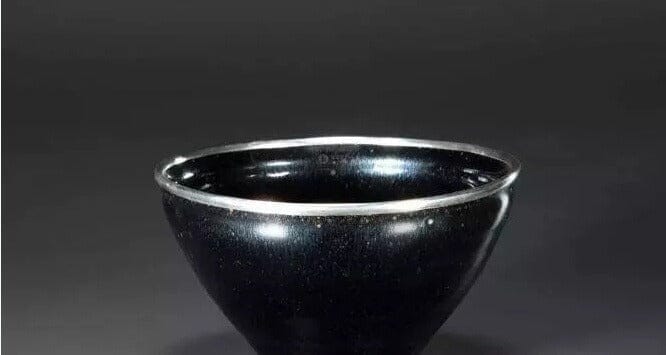Embracing the aristocratic charm of Tenmoku - Wu Jin glaze.
Emperor Huizong of Song once said, "The color of the Tenmoku should be dark blue or black." This is what connoisseurs call "ganhei" or "qianghei," which means that the black glaze shines and looks like lacquer. Black glaze is the characteristic color of Jian kiln, and it can be divided into three types: wuhei, ganhei, and qianghei. Among them, the most precious one is the pure black Tenmoku with a smooth and glossy texture, which is known as Wu Jin glaze. It has a very rich range of intermediate tones.

Jian Kiln Black-Glazed Standard Cup with Flared Mouth
We call this type of cup "Black-Glazed" cup, which is one of the small varieties of Jian cups. Often, this type of cup is shiny black all over, with a thick and lustrous glaze that is moist and reflective.
The "black" of black glaze itself is an ultimate pursuit, seeking a state of "nothingness," while also searching for a kind of variation within the black, pursuing a form of "existence." This philosophy is very close to the Daoist idea of "non-action leading to success, and only through non-action can one accomplish everything." This unique aesthetic pursuit is closely related to the Daoist philosophy that the Song dynasty revered. Lao Tzu's Tao Te Ching states: "The nameless is the beginning of heaven and earth; The named is the mother of the myriad creatures. Hence always rid yourself of desires in order to observe its secrets; But always allow yourself to have desires in order to observe its manifestations. These two are the same but diverge in name as they issue forth. Being the same they are called mysteries, Mystery upon mystery - The gateway of the manifold secrets." The "nothingness" and "existence" in this passage refer to the "Tao" that goes from "nothingness" to "existence," which is extremely compatible with the deep philosophy of Jian ware.
Yuan Dynasty Black-Glazed Silver-Threaded Cup with Flared Mouth
However, during the Northern Song Dynasty over 1000 years ago, producing black glaze was extremely difficult. From a production technology perspective, firing pure black glaze requires high temperatures and a completely oxygen-free atmosphere inside the kiln. Because kilns used to produce ceramics in the southern region were dragon kilns, which had poor air tightness, it was very easy for air to flow in, making it very difficult to produce pure black glaze.

This is why most of the ancient black-glazed ceramics we see today have a dark brown or brownish-red color, and some even have a grayish-yellow hue, because it is difficult to achieve a completely oxygen-free atmosphere inside the kiln.
Ming Dynasty or Earlier Jian Kiln Black-Glazed Cup with Flared Mouth.
However, in the development of Jian ware, the best black-glazed cups were mainly produced in the early Northern Song Dynasty. This period was a transitional period when Jian ware was reaching its peak, and it was an important period when the brown glaze began to evolve into black glaze and other patterns in Jian ware. The glaze was usually applied quite thickly, with a tendency towards drips. The glaze color was shiny black, with a lustrous and moist quality resembling jade, giving it a reflective quality.
Southern Song Dynasty Jian Kiln Black-Glazed Cup with "Seven" Mark and Hat-Shaped Lid
Jian Kiln Black-Glazed Cup with Oil-Drop Decoration and Flared Mouth.
Therefore, Jian ware is not only a tangible utilitarian vessel, but also a sublimation of the intangible Tao. The Book of Changes says, "Above, it is called Tao; below, it is called an object." Jian ware embodies this philosophical concept of Daoism very well. From the fact that neighboring country Japan has declared Song Dynasty Jian ware a national treasure, it is not difficult to understand that the status of Jian ware and its deep philosophical meaning have surpassed the tea cup itself. Japan is also widely recognized as the region that has best preserved and continued the Tang and Song Dynasty traditions of China, both in terms of aesthetics and the philosophical ideas they uphold, which are in continuity with those of the Song Dynasty.









Share:
Origins of Partridge Feather Spot Tenmoku: One-Glance Characteristics
How was the first Tenmoku kiln opened? Was it boiled before its first use?